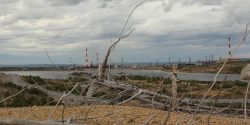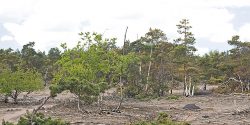Past research
I started to study the impact of industrial pollution on terrestrial biota in 1981, and these studies remained the main research direction of my team until the late 2000s. We considered impact zones of point polluters as ‘unintentional experiments’ and used these to explore the biotic consequences of environmental contamination. By combining different research methods, including field observations, experiments and meta-analysis, we demonstrated that the responses of living beings to pollution are hrerse and not always negative. Our results suggest that the development of evolutionary adaptations to pollution is a common phenomenon and that the harmful effects of pollution on terrestrial ecosystems are likely to increase as the climate warms.
Ongoing research
We have discontinued our field studies of pollution impact on terrestrial ecosystems, pursuing instead an exploration of restoration processes in contaminated areas. In addition, we analyse and prepare for publication the data that have beencollected in polluted habitats (primarily around the nickel-copper smelter at Monchegorsk) during the previous decades.
Featured publications
Hunter, M. D. & Kozlov, M. V. (2019) The relative strengths of rapid and delayed density dependence acting on a terrestrial herbivore change along a pollution gradient. Journal of Animal Ecology, 88, 665–676 (doi: 10.1111/1365-2656.12930).
We monitored populations of an eruptive leafmining moth, Phyllonorycter strigulatella, at 14 sites around a coal-fired power plant near Apatity, north-western Russia, over 26 years. We observed declines in the densities of P. strigulatella, increases in predation pressure from birds and ants, and declines in an unknown source of mortality (perhaps plant antibiosis) with increasing distance from the power plant. This pattern parallels the increasing strength of rapid (stabilizing) density dependence with increasing distance from the pollution source, whereas the strength of delayed (destabilizing) density dependence decreased. We conclude that in a rapidly changing world, effects of anthropogenic pollution may be as, or more, important than are effects of climate change on the future dynamics of animal populations.
Manninen, S., Zverev, V., Bergman, I. & Kozlov, M. V. (2015) Consequences of long-term severe industrial pollution for aboveground carbon and nitrogen pools in northern taiga forests at local and regional scales. The Science of the Total Environment, 536, 616‒624 (doi: 10.1016/j.scitotenv.2015.07.097).
Plant biomass near the nickel–copper smelter in Monchegorsk, in north-western Russia, declined to 1% of that in unpolluted forests. Pollution reduced plant biomass over an area of about 107,200 km2, and the regional loss of phytomass carbon stock was estimated at 4.24 × 1013 g C. The effects of pollution on regional carbon stock exceeded effects of fire and insect pests.
Kozlov, M. V., Zvereva, E. L. & Zverev, V. E. (2009) Impacts of point polluters on terrestrial biota: Comparative analysis of 18 contaminated areas. Springer, Dordrecht, XVII + 466 p. (ISBN: 978-90-481-2466-4).
This book is unique in identifying general patterns in responses of terrestrial biota to industrial pollution and the sources of variation in these responses. The meta-analysis is based on extensive original data on soils, plants and animals collected around 18 large industrial polluters in six countries. The variation in the direction and magnitude of changes in ecosystem parameters observed near these polluters relative to unpolluted sites was primarily explained by composition and amount of aerial emissions. Comparison of outcomes of meta-analyses of our data and of published data suggests that published results generally overestimated (by an average factor of 3.5) the magnitude of the effects of industrial pollution on terrestrial biota. This overestimation is likely to result from both research and publication biases frequently observed in pollution studies.
Kozlov, M. V. & Zvereva, E. L. (2011) A second life for old data: global patterns in pollution ecology revealed from published observational studies. Environmental Pollution, 159, 1067-1075 (doi: 10.1016/j.envpol.2010.10.028). (Review)
A synthesis of research on the responses of terrestrial biota (1095 effect sizes) to industrial pollution (206 point emission sources) was conducted to reveal regional and global patterns from small-scale observational studies. A meta-analysis showed that the effects of pollution depend on characteristics of the specific polluter (type, amount of emission, duration of impact on biota), the affected organism (trophic group, life history), the level at which the response was measured (organism, population, community), and the environment (biome, climate).
Zvereva, E. L. & Kozlov, M. V. (2010) Responses of terrestrial arthropods to air pollution: a meta-analysis. Environmental Science and Pollution Research, 17, 297-311 (doi: 10.1007/s11356-009-0138-0).
Meta-analysis of 448 effect sizes extracted from 134 studies demonstrated that the overall effect of pollution on arthropod hrersity did not differ from zero. Abundance of soil arthropods decreased near point polluters, whereas densities of herbivores increased; but the latter effect is evidently overestimated due to research biases. Overall effect of pollution on arthropod performance was negative; but this negative effect weakened with increase in duration of the pollution impact, hinting evolution of pollution resistance. Ecosystem-wide adverse effects of pollution are likely to increase under predicted climate change.
Kozlov, M. V. & Zvereva, E. L. (2007) Industrial barrens: extreme habitats created by non-ferrous metallurgy. Reviews in Environmental Science and Biotechnology, 6, 231-259 (doi: 10.1007/s11157-006-9117-9).
Industrial barrens are bleak open landscapes evolved due to deposition of airborne pollutants; they appeared as a by-product of human activities about a century ago. The comparative analysis of information available from 36 industrial barrens worldwide demonstrated that, in spite of general reduction in biohrersity, industrial barrens still support a variety of life, including regionally rare and endangered species, as well as populations that evolved specific adaptations to the harsh and toxic environment. These habitats offer unique opportunities for testing some general theories in an evolutionary novel stressful environment.
Co-authors
A. Bakhtiarov
V. Barcan
E. Belsky
I. Bergman
N. K. Brodskaya
T. Eeva
J. Eränen
A. Gilyazov
A. Girs
A. Haarto
K. Hangasmaa
E. Haukioja
†J. Jalava
P. Kaitaniemi
G. Kataev
E. Kovnatsky
K. Kuusela
M. Kytö
J. Loponen
K. Lempa
A. Lvovsky
S. Manninen
A. Markkola
†K. Mikkola
†E. Mälkönen
S. Neuvonen
J. Nielsen
V. Ossipov
O. Rigina
M. Roitto
K. Ruohomäki
A. Ruotsalainen
M. Schäfer
A. Selikhovkin
D. Stroganov
T. Tammaru
E. Toivonen
E. Vorobeichik
T. Whitworth
V. Zhirov
S. Zimina
E. Zvereva
V. Zverev
Co-operating scientists
P. Beckett
S. Bogart
V. Chepinoga
T. Chernenkova
†J. Derome
A. Doronina
A. Egorov
T. Gorbacheva
J. Gunn
E. Khantemirova
G. Konechnaya
J. Kulfan
L. Kuusisto
K. Kvapilova
N. Lukina
I. Mikhailova
H. Raitio
E. Runova
V. Savchenko
I. Sokolova
E. Szkokan
M. Trubina
†N. Tzvelev
H. Tømmervik
T. Vlasova
P. Zach
Funding
Academy of Finland
Maj and Tor Nessling Foundation

